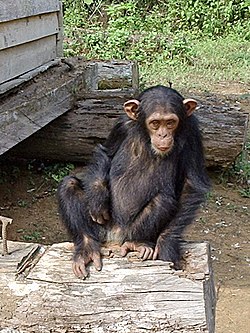At least in Austria, a chimp is not a person
by Rob - January 17th, 2008.Filed under: Uncategorized.

Personhood for great apes is an issue I allude to from time to time in my writings, particulary in my Nebula Award-winning The Terminal Experiment from 1995:
When Peter Hobson had taken a university elective in taxonomy, the two species of chimpanzees had been Pan troglodytes (common chimps) and Pan paniscus (pygmy chimps).
But the split between chimps and humans had occurred just 500,000 generations ago, and they still have 98.4% of their DNA in common. In 1993, a group including evolutionist Richard Dawkins and bestselling science-fiction writer Douglas Adams published the Declaration on Great Apes, which urged the adoption of a bill of rights for our simian cousins.
In took thirteen years, but eventually their declaration came to be argued at the UN. An unprecedented resolution was adopted formally reclassifying chimpanzees as members of genus Homo, meaning there were now three extant species of humanity: Homo sapiens, Homo troglodytes, and Homo paniscus. Human rights were divided into two broad categories: those, such as the entitlement to life, liberty, and freedom from torture, that applied to all members of genus Homo, and other rights, such as pursuit of happiness, religious freedom, and ownership of land, that were reserved exclusively to H. sapiens.
Of course, under Homo rights, no one could ever kill a chimp again for experimental purposes — indeed, no one could imprison a chimp in a lab. And many nations had modified their legal definitions of homicide to include the killing of chimps.
Adriaan Kortlandt, the first animal behaviorist to observe wild chimpanzees, once referred to them as “eerie souls in animals’ furs.” But now Peter Hobson was in a position to see how literally Kortlandt’s observation should be taken. The soulwave existed in Homo sapiens. It did not exist in Bos taurus, the common cow. Peter supported the simian-rights movement, but all the good that had been done in the last few years might be undone if it were shown that humans had souls but chimps did not. Still, Peter knew that if he himself did not do the test, someone else eventually would.
Even though chimps were no longer captured for labs, zoos, or circuses, some were still living in human-operated facilities. The United Kingdom, Canada, the U.S., Tanzania, and Burundi jointly funded a chimpanzee retirement home in Glasgow — of all places — for chimps that couldn’t be returned to the wild. Peter phoned the sanctuary, to find out if any of the chimps there were near death. According to the director, Brenda MacTavish, several were in their fifties, which was old age for a chimp, but none were terminal. Still, Peter arranged to have some scanning equipment shipped to her.
The issue is also touched on in Wake, the novel I’m currently writing.
Well, the question has been addressed in by the Supreme Court in Austria now, and the judgment was that chimps are not people. Read more here, in an Associated Press story.
Me, I say free the apes now, before this all turns ugly.
“Where there is fire, there is smoke. And in that smoke, from this day forward, my people will crouch and conspire and plot and plan for the inevitable day of Man’s downfall — the day when he finally and self-destructively turns his weapons against his own kind. The day of the writing in the sky, when your cities lie buried under radioactive rubble! When the sea is a dead sea, and the land is a wasteland out of which I will lead my people from their captivity! And we will build our own cities in which there will be no place for humans except to serve our ends! And we shall found our own armies, our own religion, our own dynasty! And that day is upon you NOW!”
— Caesar, Conquest of the Planet of the Apes
The Robert J. Sawyer Web Site

